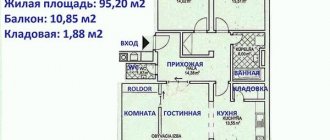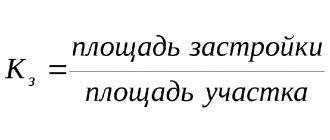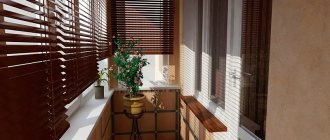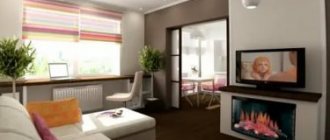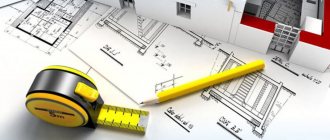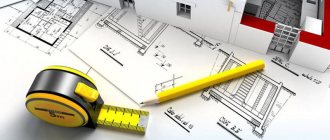Today, various real estate transactions are very popular in our country. When buying or selling an apartment, every person is faced with two concepts - main and living space. Most believe that they are the same thing, but in fact the terms have completely different meanings. It’s quite difficult to figure them out on your own, so in most cases people turn to qualified specialists. However, this is not at all necessary. Let's take a closer look at what is included in the living space of a house and how to correctly calculate it.
general information
You may be interested in: How to return insurance from Sberbank: types, procedure and example of filling out the form
Before starting the calculations, let's first understand the basic aspects. It is very important to be able to correctly determine the area of housing, since it is one of the most important criteria affecting the cost of an apartment. But you also need to understand what it includes. A living space is an isolated part of the space of a building, intended for independent use by residents. In turn, the concept of area refers to the total number of premises that are part of the apartment. Having an idea of how to calculate it correctly will help you make the most profitable real estate deal, regardless of whether you are interested in buying or selling.
Main components of the apartment
You may be interested in: CPC "Tyumen Savings Fund": reviews
What is included in the living area of the house? Before answering this question, it is necessary to understand its main components. Any property, regardless of area and number of rooms, has three of them:
- total area;
- residential;
- apartment area.
If you do not understand these concepts, you will not be able to be sure what kind of apartment you are buying. The main problem with this is that not all sellers provide such information to their clients. As a result, people overpay and face many problems in the future.
Commentary to Art. 15 Residential Complex of the Russian Federation
1. In accordance with the most common point of view, the object of the legal relationship is what this legal relationship is about. Housing legal relations arise regarding residential premises. Therefore, Part 1 of the commented article states that the objects of housing rights are residential premises.
2. An isolated premises intended for the residence of citizens is considered residential. Traditionally, isolated premises are those that have autonomous access to common areas (corridor, hallway, landing, etc.) or to the street (see also commentary to Article 16 of the Housing Code).
3. At first glance, the indication that a residential premises is recognized as an isolated premises, which is real estate, is devoid of legal content. Moreover, by virtue of Art. 1 of the Federal Law of July 21, 1997 N 122-FZ “On state registration of rights to real estate and transactions with it” (hereinafter referred to as the Law on Registration of Rights), residential premises are classified as real estate. However, this instruction makes sense. ——————————— NW RF. 1997. N 30. Art. 3594.
Unfortunately, a considerable number of citizens still live in prefabricated houses, trailers, beams, etc. Such objects are not real estate (there is no strong connection with the land). Relations regarding their use for living are not regulated by housing legislation (in appropriate cases, the norms of civil law on property lease (lease) agreements are applied). This is precisely what is emphasized by the indication that the living quarters, i.e. a thing that is the object of housing rights is recognized as a premises related to real estate.
4. Only those premises that are suitable for permanent residence of citizens are considered residential. Here (in Part 2 of the commented article) it is explained in which cases an apartment, house and other premises are considered suitable for permanent residence - they must meet established sanitary and technical rules and regulations, and other legal requirements. To resolve the issue of compliance of a particular premises with these requirements, materials from the technical inventory bureau, sanitary and epidemiological services, conclusions of technical (and other) examinations, etc. are used.
5. The procedure for recognizing premises as residential and the requirements that residential premises must meet are established by the Government of the Russian Federation, which, by Resolution No. 47 of January 28, 2006, approved the Regulations on recognizing premises as residential premises, residential premises unsuitable for habitation and an apartment building as unsafe and subject to demolition or reconstruction.
The effect of this Regulation applies to residential premises in operation located on the territory of Russia (clause 2), regardless of the form of ownership and does not apply to residential premises located in capital construction projects, the commissioning of which and registration with the state have not been carried out in in accordance with the Town Planning Code of the Russian Federation (clause 3).
6. The recognition of a premises as residential, suitable (unsuitable) for citizens to live in, as well as an apartment building as unsafe and subject to demolition or reconstruction is carried out by an interdepartmental commission created for these purposes.
Depending on the type of housing stock by form of ownership, the interdepartmental commission is created, respectively, by the federal executive body, the executive body of the subject of the Federation, or the local government body. The commission includes representatives of the body that decided to create it, as well as representatives of bodies authorized to carry out state control and supervision in the areas of sanitary-epidemiological, fire, industrial, environmental and other safety, consumer rights protection and human well-being, to carry out inventory and rehabilitation of real estate objects. Where necessary, representatives of architecture, urban planning and other relevant organizations are also involved.
The owner of the residential premises (the person authorized by him) is involved in the work of the commission with the right of an advisory vote, and, in necessary cases, experts from design and survey organizations with the right of a casting vote.
A representative of the body that made the decision to create it is appointed as the chairman of the commission (clause 7 of the said Regulations).
A local government body has the right to make a decision on recognizing private residential premises located on the relevant territory as suitable (unsuitable) for citizens to live in and delegate to an interdepartmental commission the authority to assess the compliance of these premises with established requirements and to make a decision on recognizing these premises as suitable (unsuitable) for living. citizens (clause 8 of the Regulations). ——————————— The given instructions on the powers of the interdepartmental commission contained in the Regulations under consideration appear to be contrary to the law. Thus, the recognition of residential premises of the housing stock of a subject of the Federation as unsuitable for habitation is the responsibility of the state authorities of the subject of the Federation (Clause 6, Article 13 of the Housing Code). The recognition of residential premises of the municipal housing stock as unsuitable for habitation must be carried out by local government bodies (clause 8, part 1, article 14 of the Housing Code). It is clear that the interdepartmental commission cannot be considered either a state authority or a local government body (strangely, the Resolution of the Plenum of the Armed Forces of the Russian Federation dated July 2, 2009 refers to this commission as a body (clause 22)).
7. The said Regulations define in sufficient detail for an act of this level the requirements that a residential premises must meet. In particular, requirements are formulated for the load-bearing and enclosing structures of residential premises (clause 10), the arrangement and equipment of residential premises and the common property of premises owners in an apartment building (primarily in order to prevent the risk of injury, ensure the convenience and safety of movement and accommodation (clause 11)), engineering systems (clauses 12 - 14), etc. The regulation stipulates that residential premises, as well as premises that are part of the common property of premises owners in an apartment building, must be protected from the penetration of rain, melt and ground water and possible domestic water leaks from engineering systems (clause 16); access to residential premises located in an apartment building above the fifth floor, with the exception of the attic floor, must be provided using an elevator (clause 17); placement of residential premises in the basement and ground floors is not allowed (clause 23); placement of a toilet, bathroom (shower) and kitchen above the rooms is not allowed (equipment of a toilet, bathroom (shower) on the upper level above the kitchen is possible in apartments located on two levels (clause 24), etc.
This is important to know: How is the total area divided in a communal apartment?
The Regulations also contain requirements for space-planning solutions for residential premises (clause 20), insolation (clause 21), height of premises (clause 22), electric field strength, magnetic field induction (clause 30), etc. At the same time Regulatory and technical instructions are often formulated. Thus, in a living room at a distance of 0.2 m from walls and windows and at a height of 0.5 - 1.8 m from the floor, the electric field strength of an industrial frequency of 50 Hz and the magnetic field induction of an industrial frequency of 50 Hz should not exceed 0.5, respectively kV/m and 10 µT (item 30); inside a residential premises, the equivalent radiation dose rate should not exceed the dose rate permissible for an open area by more than 0.3 μSv/h, and the average annual volumetric activity of radon in the air of operated premises should not exceed 200 Bq/cubic meter. m (clause 31).
Naturally, reference standards are also used to determine the requirements that residential premises must meet. Thus, in a residential area, permissible levels of vibration from internal and external sources during the day and at night must correspond to the values established in the current regulatory legal acts (clause 27). Similar guidance is given regarding the permissible level of infrasound (clause 28).
In some cases, requirements are defined by reference while setting a limit. For example, in a residential building, permissible sound pressure levels in octane frequency bands, equivalent and maximum sound and penetrating noise levels must correspond to the values established in regulatory legal acts, and not exceed the maximum permissible sound level in rooms and apartments during the daytime - 55 dB , at night - 45 dB (p. 26).
Sometimes requirements for residential premises are formulated using rating categories. Thus, the load-bearing and enclosing structures of a residential premises must be in a working condition in which violations that arise during operation, in particular deformability (and in reinforced concrete structures - crack resistance), do not lead to disruption of the operability and load-bearing capacity of the structures, the reliability of the residential building and ensure safe stay of citizens and safety of engineering equipment (clause 10).
Thus, determining whether a premises meets the requirements for residential premises is a rather complex process. You have to refer to a large number of regulations, conduct examinations, measurements, etc. and so on.
8. In the case when a residential house (building) is erected in accordance with the procedure established by law and put into operation, such an act as recognizing this house (premises located in it) as residential (residential) is not required. Recognition of a premises as residential in this case is limited to actions that mediate its commissioning (including checking whether it meets the requirements for residential premises), state registration and state registration of the right to it (as a residential premises).
From the above it follows that the rules contained in the above-mentioned Regulations, approved in pursuance of the instructions of Parts 3 and 4 of the commented article, apply in the following cases.
Firstly, when deciding on the transfer of non-residential premises to residential ones. In particular, such a transfer is unacceptable if the corresponding premises do not meet the established requirements or there is no opportunity to ensure compliance with the requirements (Part 4 of Article 22 of the Housing Code).
Secondly, when establishing whether the premises used as housing and, from a legal point of view, are considered residential premises, are suitable for living.
Thirdly, when deciding on the recognition of an apartment building in operation as unsafe and subject to demolition.
9. Earlier we talked about the objective, relatively speaking, grounds for recognizing residential premises as suitable (unsuitable) for living. Apparently, it is also necessary to highlight subjective circumstances that may indicate the suitability (or unsuitability) of a particular residential premises for the residence of specific persons. The Regulations, in particular, establish that separate residential premises may be considered unsuitable for residence of “disabled people and other low-mobility groups of the population who use wheelchairs due to illness” (clause 54). It seems that residential premises should be recognized as unsuitable for living by certain categories of citizens in the presence of “medical criteria”, regardless of whether wheelchairs are required, whether these citizens have them and whether they use them.
10. Summarizing what was stated when commenting on the rules contained in parts 3, 4 of this article, it can be noted that the basis for declaring a residential premises unsuitable for habitation is the presence of identified harmful factors in the human environment that do not allow ensuring the safety of life and health of citizens due to deterioration of the building as a whole or its individual parts, operational characteristics leading to a decrease in the reliability of the building, the strength and stability of building structures and foundations to an unacceptable level.
Residential premises that have a high percentage of physical wear and tear are considered unsuitable for living; located in sanitary protection, fire and explosion hazardous industrial zones, in hazardous areas of rock dumps of coal, shale mines and processing plants, areas of landslides, mudflows and snow avalanches, in territories annually flooded by flood waters; after an accident, fire, natural or man-made disaster, if restoration work is technically impossible or impractical from an economic point of view, etc.
11. In previous legislation, legal significance was usually attached not to the entire (total) area of an apartment or residential building, but only to the living area. It included only the area of the actual living quarters (rooms) and did not take into account the area of the hallway, corridor, kitchen, bathroom, etc. (according to previously accepted terminology - “utility rooms and common areas”). Currently, these facilities are referred to in the Housing Code of the Russian Federation (including in Part 5 of the commented article) as “premises for auxiliary use, intended to satisfy citizens’ household and other needs.” For example, housing was provided within the standard living area, i.e. no more than 12 sq. m of living space for each family member (Article 40 of the RSFSR Housing Code). Only living space was paid (the size of utility rooms and common areas did not matter).
In recent years, in various legal acts (including federal laws), legal significance has increasingly been given not to residential space, but to the total area of residential premises (apartments, houses). In the Housing Code of the Russian Federation, this trend has received complete design. Thus, the accounting norm and the provision norm are established based on the total (and not residential) area of the residential premises (see Article 50 of the Housing Code and the corresponding commentary). The amount of payment for rent, maintenance and repair of residential premises for tenants under social tenancy agreements and commercial rental agreements for residential premises of state and municipal housing funds is determined based on the occupied total area of the residential premises (see Part 2 of Article 156 of the Housing Code and commentary to her).
This is important to know: Fire safety requirements in multi-apartment residential buildings: rules
In this regard, it is necessary to establish what is included in the total area of an apartment or other object of housing rights. This problem is solved in part 5 of the commented article. The essence of the norm contained in it is that the total area includes everything that forms a given object of housing rights (living rooms, hallway, corridor, kitchen, dressing room, bathroom, toilet, etc.), with the exception of the objects indicated here (balconies , loggias, verandas and terraces). The list of exceptions is formulated imperatively and as exhaustive, i.e. no other federal law, other legal act or agreement can change or supplement it.
total area
Let's look at this in more detail. This concept is basic, so we will begin our analysis of the theory with it. The total area of the house is the total number of all rooms included in the apartment, intended for living and performing household needs. It is important to understand that, according to the Housing Code, it does not include balconies and loggias, which are not considered part of the apartment. However, those who want to sell their living space for as much as possible indicate them, which is a gross violation of the law.
Knowing the total area makes it possible to understand how many rooms you will get when purchasing an apartment, not only for living, but also for other needs. This indicator includes:
- bathroom;
- toilet;
- kitchen;
- bedroom;
- living room;
- hallway;
- wardrobe;
- pantry;
- corridors
- other premises.
As for balconies, loggias, terraces, verandas and the space located under the stairs, they have nothing to do with the apartment, therefore they must be indicated in a different column in the technical documentation. This nuance must be taken into account when buying/selling real estate.
Commentary to Art. 15 Residential Complex of the Russian Federation
1. Residential is understood as an isolated premises, which is real estate and is suitable for permanent residence (meets established sanitary and technical rules and regulations, and other legal requirements). It follows from this that residential premises are intended for the residence of citizens. They can be in state ownership (Article 214 of the Civil Code of the Russian Federation), municipal property (Article 215 of the Civil Code of the Russian Federation), in the ownership of citizens and legal entities (Article 213 of the Civil Code of the Russian Federation), which is reflected in Part 2 of Art. 19 Housing Code of the Russian Federation.
Let's consider the characteristics of the object of housing rights.
Firstly, this is an isolated room.
However, let us turn to Art. 76 of the Housing Code of the Russian Federation, according to which the tenant of a residential premises under a social tenancy agreement has the right to sublease part of the residential premises, i.e. and part of the room.
Thus, the object of housing rights can be not only an isolated premises; whereas the subject (object) of a housing rental agreement can only be an isolated residential premises (Article 62 of the Housing Code of the Russian Federation, Article 673 of the Civil Code of the Russian Federation).
Secondly, this is a living space. A necessary characteristic of housing is its purpose for the residence of citizens. This position is contained in Art. 17 Housing Code of the Russian Federation (Part 1). Only a room that is functionally intended for living is considered residential. Article 288 of the Civil Code of the Russian Federation (clause 2) establishes: “Residential premises are intended for the residence of citizens.”
Hotels, sanatoriums, holiday homes, boarding houses, etc. have a different functional purpose, i.e. are a place of rest and treatment. Such premises are used for temporary stay, as opposed to a place of residence. Place of residence according to Art. 20 of the Civil Code of the Russian Federation recognizes the place where a citizen permanently or primarily resides.
Thirdly, this is a premises suitable for permanent residence. This means that in terms of area, layout, illumination, insolation, microclimate, air exchange, levels of noise, vibration, ionizing and other radiation, it must comply with sanitary rules in order to ensure safe and harmless living conditions (Article 23 of the Federal Law of March 30, 1999 N 52-FZ “On the sanitary and epidemiological welfare of the population”). In addition to sanitary rules, residential premises must comply with technical rules and regulations, other legal requirements: stationary structure, the presence of certain types of amenities, auxiliary premises, etc.
2. The commented article does not mention such a requirement as landscaping. However, what is important for a person is the comfort of living, the sum of the consumer qualities of housing. An essential part of comfort is landscaping. It follows that a residential premises must meet not only sanitary and technical requirements, but also a certain degree of improvement in order for it to be the object of housing rights.
Requirements to provide residential premises with certain types of “improvement” are contained in the Regulations on the recognition of premises as residential premises, residential premises unsuitable for habitation and an apartment building as unsafe and subject to demolition, approved. Decree of the Government of the Russian Federation dated January 28, 2006 N 47.
The degree of improvement in cities and other settlements varies. In this regard, the wording of Art. 40 of the Housing Code of the RSFSR (“Requirements for residential premises”): residential premises provided for citizens to live in must be well-equipped “in relation to the conditions of a given locality.”
3. The procedure for recognizing a premises as residential and the requirements that it must meet are established by the Government of the Russian Federation (Part 3 of the commented article). The grounds and procedure for recognizing residential premises as unfit for habitation are also established by the Government of the Russian Federation (Part 4 of the commented article).
The Government of the Russian Federation adopted Resolution No. 47 of January 28, 2006, which approved the Regulations on recognizing premises as residential premises, residential premises unsuitable for habitation and an apartment building as unsafe and subject to demolition or reconstruction.
According to this Regulation, residential buildings and residential premises are considered unsuitable for living: having a certain physical wear and tear; in disrepair; in which the harmful effects of environmental factors have been identified (Section III of the Regulations).
Thus, unsuitability is determined by the degree of deterioration of housing (the extreme degree is the accident rate), namely: the presence of irreparable faults in utility networks, non-compliance with building codes when developing the territory close to the house, etc.
The criteria for classifying housing as unsuitable due to the harmful effects of environmental factors are provided for by state sanitary and epidemiological rules and regulations.
Issues regarding the recognition of residential buildings (residential premises) as unfit for habitation are resolved by interdepartmental commissions.
The federal executive body creates, in accordance with the procedure established by it, a commission to evaluate residential premises of the housing stock of the Russian Federation. The commission includes representatives of this federal executive body. An official of the specified federal executive body is appointed as the chairman of the commission.
In the same way, they create their own commissions: the executive body of the constituent entity of the Russian Federation - to assess the residential premises of the regional housing stock; local government body - to assess the residential premises of the municipal housing stock.
The owner of the housing stock or a representative of the owner performing the functions of managing the housing stock, in relation to the residential building (residential premises) of which the issue of declaring it unfit for habitation, and, if necessary, a representative of design and survey organizations, should be involved in the work of the commission, who carried out the inspection of this residential building (residential premises).
The commission, based on an application from the owner of the premises or an application from a citizen (tenant) or on the conclusion of state control and supervision bodies, assesses the compliance of the premises with the requirements established in the Regulations.
After studying the submitted documents, the list of which is provided for in clause 45 of the Regulations, and, if necessary, inspecting the residential building (residential premises), the commission makes a decision:
on the suitability of a residential building (residential premises) for living;
on the need and possibility of carrying out major repairs, reconstruction or redevelopment (if necessary, with a feasibility study) in order to bring the characteristics of the residential premises lost during operation into compliance with the requirements established in the Regulations and after their completion - on the continuation of the assessment procedure;
This is important to know: Renewal of a personal account for an apartment: where to apply, documents
on the unsuitability of a residential building (residential premises) for habitation, indicating defects that cannot be eliminated technically or the elimination of which is not economically feasible, and the criteria for unsuitability;
on recognizing an apartment building as unsafe and subject to demolition or reconstruction (clause 47).
The decision of the commission can be appealed by interested parties in court.
If a residential building (residential premises) is declared unfit for habitation due to an emergency condition or the harmful effects of environmental factors that pose a particular danger to the life and health of people, the decision must indicate to the owner (a person authorized by the owner) the need to immediately resettle citizens.
4. In accordance with Part 5 of the commented article, the total area of a residential premises consists of the sum of the areas of all parts of such premises, including the area of auxiliary premises intended to satisfy citizens’ household and other needs related to their residence in residential premises, with the exception of balconies, loggias, verandas, terraces.
Living space
As mentioned earlier, this term refers to all premises intended for the personal use of residents. At first glance, everything is very simple and clear, but, as practice shows, most people do not understand what is included in the living space of the house. And this is not surprising, because apartments can have a different number of rooms, as well as additional utility rooms. For example, each dwelling has a sanitary unit and a storage room. Some citizens classify them as living rooms, which in fact are not such.
Living space includes only premises intended for personal use. These include:
- bedroom;
- living room;
- pantry.
When calculating this indicator, the bathroom, kitchen, corridor and other premises that are of a secondary nature and are not intended for living are not taken into account.
Article 15. Objects of housing rights
1. The objects of housing rights are residential premises.
2. Residential premises are recognized as isolated premises, which are real estate and are suitable for permanent residence of citizens (meet the established sanitary and technical rules and regulations, and other legal requirements (hereinafter referred to as the requirements).
3. The procedure for recognizing premises as residential premises and the requirements that residential premises must meet, including for its adaptation and adaptation of common property in an apartment building taking into account the needs of people with disabilities, are established by the Government of the Russian Federation in accordance with this Code and other federal laws.
4. Residential premises may be declared unfit for habitation on the grounds and in the manner established by the Government of the Russian Federation.
5. The total area of a residential premises consists of the sum of the area of all parts of such premises, including the area of auxiliary premises intended to satisfy citizens’ household and other needs related to their residence in residential premises, with the exception of balconies, loggias, verandas and terraces.
Apartment area
This term refers to the entire property. It includes both the common and residential area of the apartment building, as well as additional facilities. It is in it that the balcony and loggia are indicated, for which the space is called useful. In our country, this indicator is taken into account when concluding real estate transactions, while abroad only operated premises are taken into account. Because of this, many people have a misunderstanding of the difference in different types of area. How to calculate it correctly will be discussed below.
Letter from the Ministry of Regional Development of the Russian Federation dated November 22, 2012
The values of the total area of a residential premises (apartment), non-residential premises in an apartment building used when calculating the amount of payment for utility services in accordance with the Rules for the provision of utility services should be determined on the basis of the data contained in the document confirming the right of ownership (use) of the premises in an apartment building , a transfer deed or another document on the transfer by the developer of premises in an apartment building, a technical passport of a residential premises (apartment) or a technical passport of an apartment building, and the value of the total area of all premises in an apartment building, the total area of premises included in the common property in an apartment building, the total area of all residential premises (apartments) and non-residential premises in an apartment building should be determined on the basis of the data contained in the technical passport of the apartment building.
In accordance with paragraph 40 of the Rules for the provision of utility services to owners and users of premises in apartment buildings and residential buildings, approved by Decree of the Government of the Russian Federation of May 6, 2011 No. 354 (hereinafter referred to as the Rules for the provision of utility services), the consumer of utilities in an apartment building, regardless of depending on the chosen method of managing an apartment building, as part of the payment for utility services, it separately pays for utilities provided to the consumer in residential or non-residential premises, and payment for utilities consumed during the use of common property in the apartment building.
- An essential condition of the contract for the sale of a residential building, apartment, part of a residential building or apartment in which persons live who, in accordance with the law, retain the right to use this residential premises after its acquisition by the buyer, is a list of these persons indicating their rights to use the residential premises being sold.
- A contract for the sale of a residential building, apartment, part of a residential building or apartment is subject to state registration and is considered concluded from the moment of such registration.
- The specifics of the purchase and sale of residential premises that meet the conditions for classification as economy class housing established by the authorized federal executive body are determined by law.
Area is the main parameter for carrying out technical inventory and statistical accounting of both types of real estate in the Russian Federation. Calculations for the consumption of utilities, rental housing, and repair work are also carried out based on the value of this indicator.
Why know the size of your living space?
Let's look at this aspect in more detail. This indicator may be necessary to achieve a variety of goals. So, for example, without knowing the living space of the house you will not be able to:
- design a plan for future housing;
- draw up an estimate necessary for the construction of a new building;
- carry out interior decoration of the premises;
- prepare documents for an apartment;
- remodel the house;
- carry out various real estate transactions, for example, renting out or selling;
- draw up a technical plan for housing.
If the calculations are incorrect, various problems can arise that can result in significant financial losses. Therefore, you must be able to independently determine the living area of the property. Read on to find out how to do this.
Calculation rules
We have understood the concepts and main components of apartments. Now let's figure out how to calculate living space. This aspect is one of the most important, since it is it that has a key influence on the formation of the value of real estate. It was described above which premises fall under the definition of residential, so there should not be any problems with the calculations. Everything is very simple. You must determine the footage of each room and put together the results.
In addition, you can find out the area of the apartment from the technical passport, which is stored in the BTI. To obtain it, you need to contact a separate bureau, providing the following package of documents:
- passport;
- a document certifying the ownership of housing;
- application of the established form;
- receipt for payment of state duties.
If a registration certificate was not issued for the apartment or redevelopment was carried out in it, then in this case you need to call a specialist to take all measurements and draw up the appropriate documentation. You can also use the services of independent organizations specializing in calculating the living space of a house, however, you will have to pay for their services. But there is also a positive side, namely the speed of completion of the work. They will be able to do everything in a few days, while the wait for a specialist from BTI can drag on for several months.
BTI measurements
BTI measurements are most often used to determine the actual area of a room. This information is necessary when concluding various real estate transactions and coordinating its redevelopment. Measurements of premises parameters are carried out in accordance with certain rules that are approved by the state and have a fairly large number of nuances.
They are known to specialists in the real estate market, who, if necessary, can protect the interests of the owner of a building or premises and go to court to challenge the measurement results, therefore it is recommended to entrust work with BTI in this part to specialized companies.
It may be a little more expensive, but it will save time and get guaranteed results.
Why are BTI measurements needed?
In most cases, the technical inventory bureau is contacted in situations where it is necessary to find out the actual area of the property. This information may be required when settling relations with the developer and registering ownership of the property. BTI also measures the apartment to solve the following problems:
- Determination of the planned cadastral value of real estate. Based on this, taxes will be calculated, sales transactions will be made, and so on.
- Recognize the object as residential or non-residential, depending on compliance with legislative sanitary standards for premises (SNiP). In addition, information about the area according to the BTI may be required in a situation where a decision is made about the possibility of registering relatives or friends in the apartment.
- Calculation of utility tariffs in the absence of meters is carried out based on the actual area. The BTI issues a certificate of its value based on the measurements taken.
- In certain cases, property owners are entitled to benefits and subsidies. To determine their size, data on the area of the property may also be required.
- Providing information about real estate to judicial authorities, as well as for resolving conflicts with the involvement of intermediaries (mediators).
It is possible to carry out measurements with the involvement of the state BTI, but such services may well be provided by commercial organizations that have employees with relevant experience and knowledge, as well as the necessary equipment and tools.
Basic rules of procedure
BTI measurements are carried out taking into account the following features:
- When determining the size of a living space, rooms with a width of less than two meters are excluded.
- Calculation of BTI areas is carried out rounded to one decimal place.
- The rules for measuring premises provide for rounding linear dimensions to the third decimal place.
- Various built-in architectural elements and furniture, as well as vernades, are taken into account when determining the size of the living space.
- The presence of walls, partitions, arches and other similar structural elements must be indicated on the drawings of non-residential and residential premises, which are prepared in the process of preparing technical passports.
- If there are several floors in a building, a plan of each floor must be drawn up, which means its measurements must be made.
- The area of the balcony block is taken into account when preparing BTI documents with a coefficient of 0.3, and the loggia with a coefficient of 0.5 (the essence of the difference between a balcony and a loggia is that the loggia does not protrude beyond the façade of the building).
- Considering the quality of construction of buildings, it is rare to find perfectly rectangular rooms; trapezoidal ones are much more common, so it is recommended to measure all four walls and then calculate the area.
- If the room is built with a complex shape, the instructions for determining its area require first dividing it into rectangles, and then summing the obtained data.
BTI measurements in a new building
This procedure is mandatory for the developer. Before handing over a residential building to the state commission, it is first necessary to determine all the areas of apartments in the new building. This will allow you to accurately identify each premises when transferring it to its owner and avoid problems when registering documents with a justice institution.
To carry out measurements of areas in a new building, it is recommended to call specialists who have the necessary equipment and tools and knowledge of the methodology for determining residential and auxiliary area and reflecting this information in the BTI passport. If you incorrectly measure the parameters of the premises, there may be negative consequences when determining the amount of utility bills and the amount of property tax, so the accuracy of measurements plays an important role in the process of measuring the BTI.
It is important to consider that the area of premises is calculated not on the basis of design documentation for a house or building, but on the basis of actual measurements. The total area of a building is defined as the sum of the areas of all available indoor spaces, which include the basement, stairs, kitchen, corridor, toilets and bathrooms. The attic floor in BTI is also considered separately.
Minimum premises requirements
When designing a house or any other, you need to know the requirements for real estate in the housing sector. Otherwise, based on the results of BTI measurements, premises that do not comply with the parameters established by regulations will be recognized as non-residential, and the house cannot be put into operation.
In particular:
- The minimum possible area of a living room should be 12 sq.m., a kitchen should be 6 sq.m., and if it has a gas boiler, then the area cannot be less than 8 sq.m., the bedroom should not be less than 7 sq.m. .
- The ceiling height in residential premises must be at least 2.5 meters; in the attic floor it can be 2.3 meters. For verandas, corridors and other auxiliary rooms, a ceiling height of 2.1 meters is allowed.
- There are also requirements for the technical dimensions of glass in the loggia and the height of the balcony railing. They are reflected in the relevant sanitary norms and standards that establish the parameters for the construction of residential buildings.
